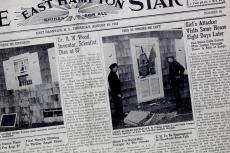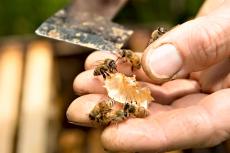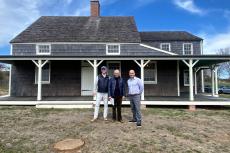Plant fanciers interested in unusual flora will want to stop by Wittendale's Florist in East Hampton, where the rare large bloom of a corpse flower is currently filling the greenhouse with its distinctively pungent odor.
Although this is the second of two Amorphophallus konjacs to bloom at the shop in three weeks, the phenomenon is hardly common, explained Donald Horowitz, an owner of Wittendale's. In fact, this is the first time the plants have bloomed since he began growing them about five years ago, and they are not likely to flower again for another two or more years. The massive flowers are at their stinkiest for just a day or two.
Mr. Horowitz's are dwarf versions. The larger Amorphophallus titanums might bloom only once a decade, and when they do, it can be quite an event in the horticultural community. When one flowered in 2015 at the Chicago Botanic Garden, thousands of people lined up for a chance to see and smell it in its full glory. The flower of the larger variety can be up to four and a half feet tall.
The plant gets its nickname from its foul smell, reminiscent of -- that's right -- rotting flesh.
In its native Sumatra, when an Amorphophallus flowers, the plant actually generates heat, which carries the scent "up to the canopy of the forest," Mr. Horowitz said, where it spreads out over a wide distance. The intense dead-animal odor of this rain forest dweller's bloom serves to "lure in flies and other insects looking for a good place to lay eggs," according to the website of the Liberty Hyde Baily Conservatory at Cornell University's College of Agriculture and Life Sciences. "These insects then deliver pollen to other A. konjacs."
Mr. Horowitz is a Cornell alum. His corpse flowers were gifts from members of Cornell's undergraduate horticultural club, Hortus Forum. Mr. Horowitz donates plant material to the club. "One of the students wanted to reciprocate and give me something a little unique," he said in the greenhouse on Thursday. The first gift was the a bulb-like corm of Amorphophallus konjac. He planted it, tended it, and has watched it grow since then. The next year, another student gave him a seedling, which, in the case of this giant, means a plant several feet high.
For several years, the plants produce only foliage, and then go into a dormant stage, "almost like an amaryllis or daffodil with no flower," Mr. Horowitz said. Last spring, one of the plants suddenly grew so big that it cracked its pot. When he went to repot it, he realized that the bulb had grown to the size of a cantaloupe. He put it in a new pot, and a few months later, it cracked that pot.
In February, he started to notice that the first plant was sprouting little buds that looked different from the growth he had observed during its previous foliage cycles. The second plant, which came from the same mother plant, followed about three weeks behind. Its flower began to unfurl late on Tuesday and by Wednesday, its fascinatingly gross scent permeated the greenhouse.
On Thursday, it had abated a bit but was still quite powerful.
Undaunted by the odor, Mr. Horowitz, who owns Wittendale's with Robert Dale, is happy to share the horticultural oddity with curious visitors, but hurry! It will only be in flower for another day at best.
And patient observers might want to mark their calendars for, say, 2024. Mr. Horowitz is also tending a giant Amorphophallus titanum given to him as a seedling by a greenhouse grower at Cornell. "This one probably has about six more years before it will mature enough to flower," he said.




